
Celery is a marshland plant in the family Apiaceae that has been cultivated as a vegetable since antiquity. Celery has a long fibrous stalk tapering into leaves. Depending on location and cultivar, either its stalks, leaves or hypocotyl are eaten and used in cooking. Celery seed powder is used as a spice.
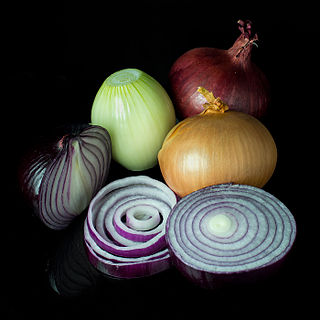
An onion, also known as the bulb onion or common onion, is a vegetable that is the most widely cultivated species of the genus Allium. The shallot is a botanical variety of the onion which was classified as a separate species until 2011. Its close relatives include garlic, scallion, leek, and chive.

Rhubarb is the fleshy, edible stalks (petioles) of species and hybrids of Rheum in the family Polygonaceae, which are cooked and used for food. The plant is a herbaceous perennial that grows from short, thick rhizomes. Historically, different plants have been called "rhubarb" in English. The large, triangular leaves contain high levels of oxalic acid and anthrone glycosides, making them inedible. The small flowers are grouped in large compound leafy greenish-white to rose-red inflorescences.
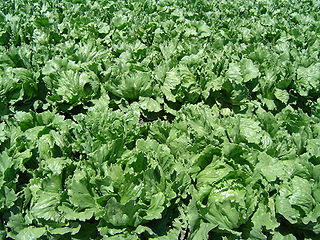
Lettuce is an annual plant of the family Asteraceae. It is most often grown as a leaf vegetable, but sometimes for its stem and seeds. Lettuce is most often used for salads, although it is also seen in other kinds of food, such as soups, sandwiches and wraps; it can also be grilled. One variety, celtuce, is grown for its stems, which are eaten either raw or cooked. In addition to its main use as a leafy green, it has also gathered religious and medicinal significance over centuries of human consumption. Europe and North America originally dominated the market for lettuce, but by the late 20th century the consumption of lettuce had spread throughout the world. As of 2021, world production of lettuce and chicory was 27 million tonnes, 53 percent of which came from China.

Common chicory is a somewhat woody, perennial herbaceous plant of the family Asteraceae, usually with bright blue flowers, rarely white or pink. Native to the Old World, it has been introduced to the Americas and Australia. Many varieties are cultivated for salad leaves, chicons, or roots, which are baked, ground, and used as a coffee substitute and food additive. In the 21st century, inulin, an extract from chicory root, has been used in food manufacturing as a sweetener and source of dietary fiber.

Endive is a leaf vegetable belonging to the genus Cichorium, which includes several similar bitter-leafed vegetables. Species include Cichorium endivia, Cichorium pumilum, and Cichorium intybus. Chicory includes types such as radicchio, puntarelle, and Belgian endive.

Chard or Swiss chard is a green leafy vegetable. In the cultivars of the Flavescens Group, the leaf stalks are large and often prepared separately from the leaf blade; the Cicla Group is the leafy spinach beet. The leaf blade can be green or reddish; the leaf stalks are usually white, yellow or red.

Celeriac, also called celery root, knob celery, and turnip-rooted celery, is a variety of celery cultivated for its edible stem or hypocotyl, and shoots. Celeriac is like a root vegetable except it has a bulbous hypocotyl with many small roots attached.

The cardoon, Cynara cardunculus, also called the artichoke thistle, is a thistle in the family Asteraceae. It is a naturally occurring species that also has many cultivated forms, including the globe artichoke. It is native to the western and central Mediterranean region, where it was domesticated in ancient times and still occurs as a wild plant.

Radicchio, sometimes known as Italian chicory because of its common use in Italian cuisine, is a perennial cultivated form of leaf chicory. It is grown as a leaf vegetable and usually has colorful, white-veined red leaves that form a head. Radicchio has a bitter and spicy taste that mellows if it is grilled or roasted.

Green beans are young, unripe fruits of various cultivars of the common bean, although immature or young pods of the runner bean, yardlong bean, and hyacinth bean are used in a similar way. Green beans are known by many common names, including French beans, string beans, and snap beans or simply "snaps." In the Philippines, they are also known as "Baguio beans" or "habichuelas" to distinguish them from yardlong beans.

Mesclun is a mix of assorted small young salad greens that originated in Provence, France. The traditional mix includes chervil, arugula, leafy lettuces and endive, while the term mesclun may also refer to a blend that might include some or all of these four and baby spinach, collard greens, Swiss chard, mustard greens, dandelion greens, frisée, mizuna, mâche, radicchio, sorrel, or other fresh leaf vegetables.
This is an alphabetical index of articles related to gardening.

Lettuce mosaic virus (LMV) is a typical potyvirus, which causes one of the major virus diseases of lettuce crops worldwide.
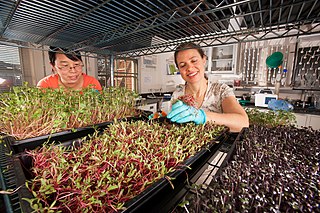
Microgreens are vegetable greens harvested just after the cotyledon leaves have developed with one set of true leaves. They are used as a visual, flavor and texture enhancement. Microgreens are used to add sweetness and spiciness to foods. Microgreens are smaller than “baby greens” because they are harvested soon after sprouting, rather than after the plant has matured to produce multiple leaves.
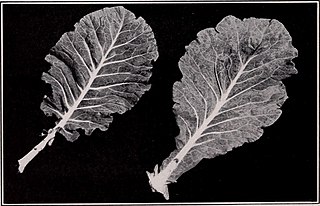
Radichetta is a type of chicory, similar to radicchio. It can be eaten raw as a salad green, or in sandwiches, and can also be used as a garnish. It has a soft texture and mildly bitter flavor.

Lacinato kale is variety of kale from the Acephala group of cultivars Brassica oleracea grown for its edible leaves. Lacinato or, in Italian and often in English, cavolo nero has a long tradition in Italian cuisine, especially that of Tuscany. It is also known as Tuscan kale, Italian kale, dinosaur kale, kale, flat back kale, palm tree kale, or black Tuscan palm. Lacinato kale has been grown in Tuscany for centuries, and is one of the traditional ingredients of minestrone and ribollita.

The Celebrity tomato cultivar is a hybrid (biology) that produces long fruit-bearing stems holding 20 or more very plump, robust tomatoes. Fruits weigh approximately 8 oz., and are 4 inches across. Plants need caging or staking, and produce fruit throughout the growing season. The celebrity tomato is a cultivar of the species Solanum lycopersicum. It is a crossbreed of the common tomato that is widely used for various culinary purposes. This tomato is of great size and is known to be resistant to most tomato diseases such as Fusarium wilt, Verticillium wilt, Tobacco mosaic virus and Root-knot nematode due to its hybrid nature. Celebrity tomatoes are highly adaptive to harsh environments and can grow in a wide range of places including dry, humid and wet regions. They are resistant to cracking and splitting which usually occurs when there is an excess of water and sugar movement in the fruits. Therefore, causing the tomato skin to grow at a slower rate compared to the expansion of the fruit. They can survive in harsh uneven rainfall. However, they are highly susceptible to colder environments and are at a higher risk of dying in regions with short growing seasons. The plants can grow up to 5 feet in height with bright red medium-sized fruits. The plants are generally very thick and grow in clusters. The tomato fruits are mostly used in the making of various salsas, salads, juices and canned food.
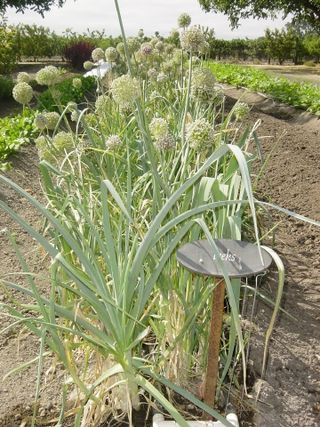
The leek is a vegetable, a cultivar of Allium ampeloprasum, the broadleaf wild leek. The edible part of the plant is a bundle of leaf sheaths that is sometimes erroneously called a stem or stalk. The genus Allium also contains the onion, garlic, shallot, scallion, chives, and Chinese onion. Three closely related vegetables, elephant garlic, kurrat and Persian leek or tareh, are also cultivars of A. ampeloprasum, although different in their uses as food.


















